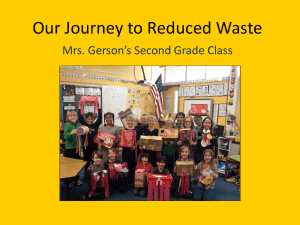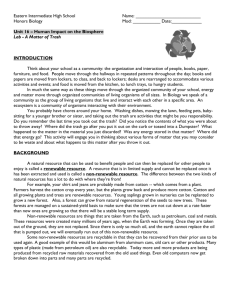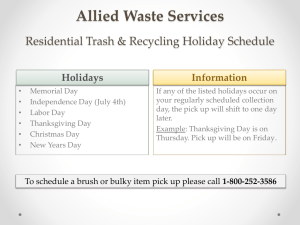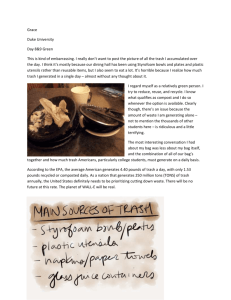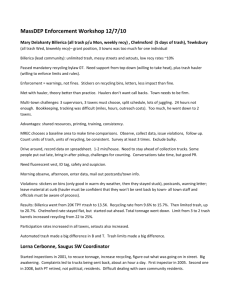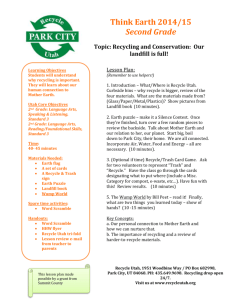File - Roberto Jimenez Writing 10 Portfolio
advertisement
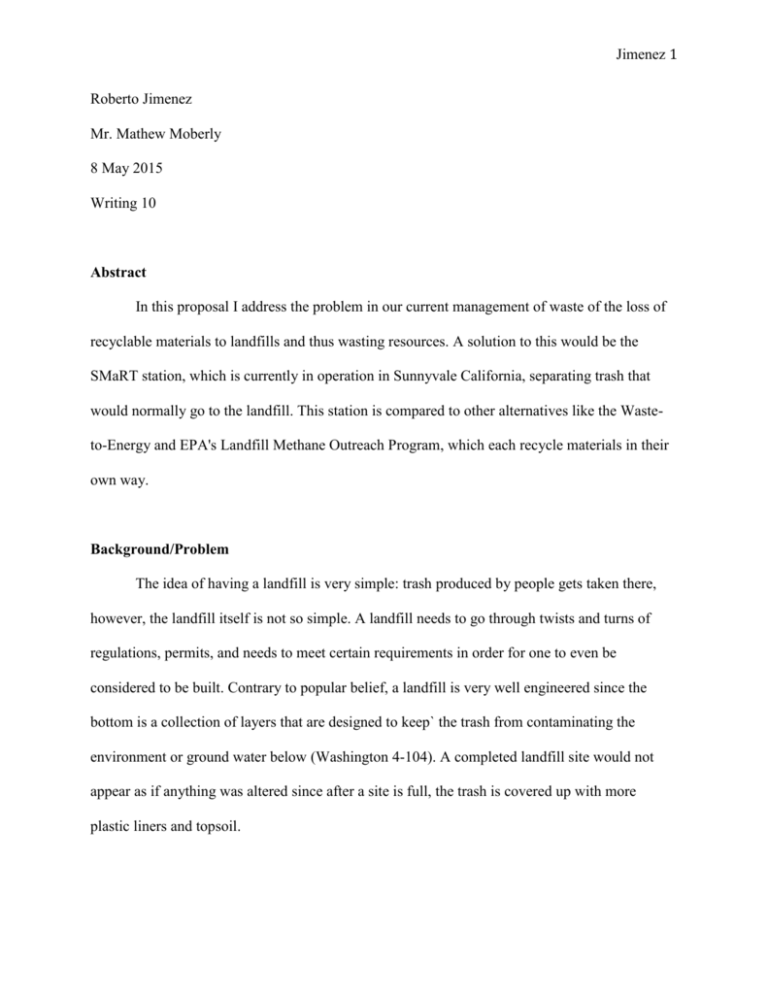
Jimenez 1 Roberto Jimenez Mr. Mathew Moberly 8 May 2015 Writing 10 Abstract In this proposal I address the problem in our current management of waste of the loss of recyclable materials to landfills and thus wasting resources. A solution to this would be the SMaRT station, which is currently in operation in Sunnyvale California, separating trash that would normally go to the landfill. This station is compared to other alternatives like the Wasteto-Energy and EPA's Landfill Methane Outreach Program, which each recycle materials in their own way. Background/Problem The idea of having a landfill is very simple: trash produced by people gets taken there, however, the landfill itself is not so simple. A landfill needs to go through twists and turns of regulations, permits, and needs to meet certain requirements in order for one to even be considered to be built. Contrary to popular belief, a landfill is very well engineered since the bottom is a collection of layers that are designed to keep` the trash from contaminating the environment or ground water below (Washington 4-104). A completed landfill site would not appear as if anything was altered since after a site is full, the trash is covered up with more plastic liners and topsoil. Jimenez 2 The landfill itself is very well engineered, however, the trash that goes into one is not separated or regulated and depends mostly on the community to do their part in sorting the trash into their proper containers. For example, where I live we sort household trash in a black container, organic plant matter in a green container and all recycles in a grey container, which the garbage trucks come and pick up every week. Waste regulations and the measuring of how much waste we produced didn’t begin until the 1960s (Cooper 14). However, to this present day even with these regulations and guidelines to follow, waste that goes to the landfill is still unsorted and unregulated. In 2012, the United States Environmental Protection Agency (EPA) reported that the United States produced 251 million tons of municipal solid waste (MSW) or household trash (United States “Municipal”). This amount of trash seems perfectly acceptable since the US has a huge population, however, out of the 252 million tons of MSW produced, only 87 million tons were recycled. The other 164 million tons were discarded in landfills across the US. Since MSW goes unsorted anything that would go into the household trash container: the plastic bags that contain the trash, paper, any cardboard, food packaging, and any other material that lands in that container, will go strait to the landfill. The problem residing with this act is that any resources that went into making of those products are now lost to the landfills. The plastic bags that contained the trash will take 500-1000 years to degrade in a landfill environment since its not being exposed to air or the elements that help decompose trash (Kiener 5). Plastic bags are made from oil and all the oil that went into making those plastic bags will never be able to be put back into production again since it will be in a landfill for 500-1000 years. The United States consumes about 80 percent of the world’s resources and that also means that we are the main producers of trash (Cooper 1). All the resources that went into making products for the US will be lost if the recyclables are not Jimenez 3 separated from the waste. If this continues this would only add to the depletion of the world's natural resources. The US society is using more resources now than it ever has in history and if this were to continue it would also damage any generation’s future. Resources would be scarce due to the wastefulness of the society and wouldn’t be able to support any civilization for long. A civilization can’t continue to grow if all the resources are used up and wasted. Recycling now as much as possible will delay this from occurring. As of 2012, the US's recycling rate was at 34 percent and has been on a steady increase since 1960,when it was at 6.4 percent, which was when EPA first started measuring our waste production and recycling (United Sates “Municipal”). Recycling efforts have increased and there are many other methods now that focus on the recycling of materials in one-way or another, but if immediate action is not done, we could be setting a bad course for the next future generations. Solution A better way to manage our waste would be to design a better sorting system or process that would allow more recyclable materials to be saved from landfills. Only allowing organics materials to the landfills will also have a smaller impact on the environment since they would naturally decompose. There are several methods that have emerged that involve the recycling of resources in one way or another. For example, the EPA encouraged the capture and use of the methane that is made from the decomposing waste with its Landfill Methane Outreach Program (LMOP) (United States “Methane”). The LMOP lead to the methane being used as a fuel source in order to create electricity. Another method of resource recovery is the waste-to-energy (WTE) method that landfills use, which takes waste and burns it in order to produce electricity: same outcome as the LMOP, but a different method. A final method that is similar to WTE is one that Jimenez 4 was created by American Chemistry Council. The American Chemistry Council takes soiled recyclables, like plastic food containers that still have food in them, and shreds them and mixes it with paper in order to create a high energy fuel that can be used to power cement kiln for electricity (American Chemistry Council). All these methods are very creative and innovative, however, they are still wasting valuable resources by burning them. Natural resources are only made once, like oil used to make plastics, and burning them instead of recycling them is a big mistake. A better designed sorting process like the SMaRT station would be the better alternative to these other methods because resources will not be lost, but instead be sorted and recycled. There are other methods of recycling that are implemented in order to regain lost resources in one form or another, like American Chemistry Councils method. They use an energy recovery method which consists of gathering any recyclables that have been soiled by food that could make the object unrecyclable, and then shredding it and mixing it with paper and making a mixture that consists of 40% paper and 60% plastic that is used as a fuel to run a cement kiln (American Chemistry Council). This method does produce fuel that has a higher energy content than most coals, however, the process of burning the precious plastics that are considered nonrecyclable converts the resources that were used to make that product into ash, which cannot be put back into production. Another flaw in this method is that The American Chemistry council only focuses on recyclable trash. This means they do not interact with municipal waste, which is the main type of waste that goes towards landfills. A method that interacts with the municipal waste is Sunnyvale Materials Recovery and Transfer Station or other wise known as their SMaRT Station. The SMaRT station interacts with the waste and separates any recyclables found for later recycling instead of burning them. The station also does not have any byproducts other Jimenez 5 than the fuel to run the station since people separate most of the trash (City of Sunnyvale California). Another method similar to American Chemistry Council’s is landfills Waste-to-Energy method (WTE), which uses a technique called mass burning. The way landfills use this is they take any trash and simply burn it in order to produce electricity. This method of energy recovery burned 29 million tons of trash in 2010, which was about 11.7 percent of all the trash produced that year (United States “Municipal”). According to California Energy Commission the trash that heads to WTE power plants is “unprocessed or minimally processed,” which means there is a high possibility that there are recyclables being burned. Along with burning valuable resources, the plants also have an issue “meet[ing] air quality requirements,” which causes a concern for the community surrounding these types of plants (California Energy Commission). A better alternative would be the SMaRT station since the station does not involve the burning of any trash and doesn’t produce any harmful pollutants to put in the air. The station simply separates the valuables from the trash and recycles them for later commercial use. EPA's Landfill Methane Outreach Program (LMOP) is a program where EPA encourages landfills to capture the methane that is created from the decomposing trash and then uses it as an energy resource. The capturing of methane for energy use can produce a broad range of electricity generation depending on which method is chosen. For example, a couple methods include the powering of an internal combustion engine, microturbine and or even a gas turbine, which produce a good amount of electricity ranging from kilowatts to megawatts (United States “Methane”). The LMOP is a very smart way of making landfills resourceful, however, this method does not help towards fixing the problem of losing resources to landfills. The problem needs to be fixed by actually taking the recyclable resources out of landfills and put them back Jimenez 6 into production. The LMOP program depends on organics materials to decompose, but it’s estimated that plastics would take up to 500-1000 years to decompose in a landfill environment (Kiener 5). The plastics and recyclable materials wouldn’t contribute anything towards the making of the methane since they take such a long time to decompose. The SMaRT would change this since it does take out as much recyclable materials as possible from the trash and recycles them. Although the previous methods do regain the lost materials in different forms, they either burn or don’t do anything towards fixing the problem. A perfect example of what should be implemented at every landfill is the SMaRT Station that is currently in the City of Sunnyvale California. This station separates not only recyclable trash, but also landfill waste (City of Sunnyvale California). This station has the highest recycling rate at nearly a 47 percent resource recovery, by my calculation. This is 12 percent higher than EPA's 34.5 percent that was reported in its 2012 fact sheet (United States “Municipal”). 12 percent higher may not seem like a lot, however, EPA's 2012 fact sheet shows that from 1960-1985, there was an increase in the recycling rate from 6.4 percent to 10.2 percent over the 25 year period (Unites States “Municipal”). Over a span of 25 years the rate only increased by 3.7 percent, however, from 1990-present there was an increase of 18.5 percent from 16 percent to 34.5 percent (United States “Municipal”). This is an 18 percent increase in 22 years, however, the SMaRT Station managed to increase its recycling rate by 12 percent from when they first started collecting data in 2009 from the station. The success of the stations recycling rate is due to their location and their separation process. The SMaRT station is strategically placed in a transfer station. This is where other waste management stations make the mistake of just transferring the trash into the vehicles to either Jimenez 7 landfills or commercial buyers. But the SMaRT station separates both recyclable and house hold waste that comes in. Household trash gets sorted by hand then mechanically treated by having trash bags ripped open and the insides separated by hand again later on a conveyor belt. The separation process is explained through a flowchart and a virtual video tour that’s provided by their website (City of Sunnyvale California). Other waste management transfer stations do not have this process and thus recyclable materials continue to be lost to landfills. The station also does not produce any pollutants into the environment and helps reduce the carbon foot print since instead of making new materials from virgin resources, they can just recycle the ones that the SMaRT station saved. Conclusion From the first time EPA first began to record our trash production during the 1960s, the recycling rate of The United States has been on a steady rise ever since. The different methods in effect now are experimentations on how to manage our trash, but the SMaRT station is the best option. Resources are recovered not burned. Even though the recycling rate is still pretty low, this is a step towards the right direction especially since the SMaRT station will increase the rate even more. Managing our trash in a healthy way, like how the SMaRT station does, will prevent the loss of valuable recourses that go into making products since they will be rescued from landfills or incinerators. Even if there is a steady rise in our country's recycling rate, never in history have we ever consumed so many resources in such a small period of time. Now, more than ever, do the lives of our future generations lie in the hands of this present generation. Managing our trash more efficiently will help all the future generations by leaving the abundant resources for civilization to exist. Jimenez 8 Works Cited American Chemistry Council. "Energy Recovery." American Chemistry Council. American Chemistry Council, 2005-2014. Web. 15 Mar. 2015. California Energy Commission. "Municipal Solid Waste Power Plants." California Energy Commission. Ed. California Energy Commission. N.p., n.d. Web. 2 May 2015. City of Sunnyvale California. A Day in the Life of Your Garbage and Recyclables. Youtube. Youtube, 15 Dec. 2009. Web. 15 Mar. 2015. Cooper, Mary H. "The Economics of Recycling." CQ Researcher 27 Mar. 1998: 265-88. Web. 15 Mar. 2015. Kiener, Robert. "Plastic Pollution." CQ Global Researcher 1 July 2010: 157-84. Web. 15 Mar. 2015. "SMaRT Station® Annual Report 2012-2013." N.d. PDF file. United States Environmental Protection Agency. "Landfill Methane Outreach Program." United States Environmental Protection Agency. Ed. United States Environmental Protection Agency. N.p., n.d. Web. 1 May 2015. United States Environmental Protection Agency. "Municipal Solid Waste Generation, Recycling, and Disposal in the United States: Facts and Figures for 2012." 2012. PDF file. Washington State Department of Ecology. "Landfill Design." Solid Waste Landfill Design Manual Washington State Department of Ecology. Comp. Inc Parametrix. Bellevue: Parametrix, 1987. 4-102-117. PDF file.


